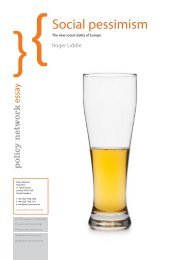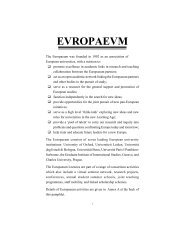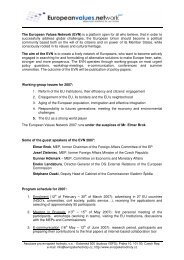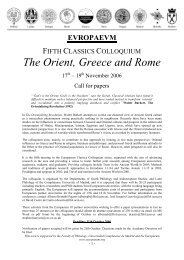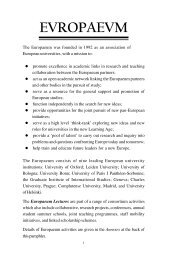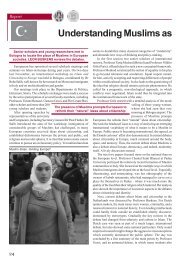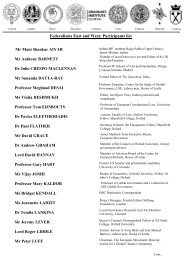Authors Iain Begg | Gabriel Glöckler | Anke Hassel ... - The Europaeum
Authors Iain Begg | Gabriel Glöckler | Anke Hassel ... - The Europaeum
Authors Iain Begg | Gabriel Glöckler | Anke Hassel ... - The Europaeum
You also want an ePaper? Increase the reach of your titles
YUMPU automatically turns print PDFs into web optimized ePapers that Google loves.
labour market. Movements of labour and capital after EU enlargement<br />
have increased. Migrant workers are often hired on lower wages and<br />
put existing wages under pressure. Since the late 1990s, new forms of<br />
employment contract such as part-time work, self-employment and<br />
temporary employment have spread. <strong>The</strong>y helped to boost employment but<br />
also led to more precarious employment conditions often associated with<br />
lower wages. Also, the progressive decline in trade union membership and<br />
collective bargaining coverage observed in most EU countries contributed<br />
to a further polarisation of wages.<br />
In particular, the pressure has been applied on the low skilled and low paid<br />
at the bottom of the labour market. While mid-level incomes have more or<br />
less remained stable over the last two decades, incomes at the lower end of<br />
the labour market have dropped. <strong>The</strong> in-work poverty risk in the EU has<br />
increased in all countries for which data is available (see graph on in-work<br />
poverty). In some countries, the increase has been substantial. This has to<br />
do with the trend towards activation of the low skilled, that previously have<br />
not been able to find work. Social inequality is therefore strongly connected<br />
with issues of activation, and employment of the low-skilled.<br />
<strong>The</strong> complex interaction between minimum wages, subsidies for the lowskilled,<br />
minimum incomes and other forms of redistribution needs to be<br />
at the centre when considering a new social safety net for the EU. It should<br />
focus on the reasons and dynamic of the rise of in-work poverty in Europe.<br />
This interaction is highly country-specific and cannot be “Europeanised”<br />
easily. But we have learned from Lisbon and the ensuing agendas and<br />
approaches that benchmarks can serve as point of orientation for national<br />
policymakers. In this case, the combination of high employment levels<br />
and strong measures of activation with relatively generous forms of<br />
redistribution through social policy should guide European policymaking.<br />
Some of these benchmarks, such as high employment levels, are already<br />
included in the Lisbon Strategy. Others, such as family friendly social<br />
policy and other forms of redistribution, should be included as well.<br />
Moreover, social partners and wage bargaining institutions as one of the<br />
main pillars of ensuring wage and income equality should continuously<br />
be encouraged and fostered, rather than reliance on statutory measures<br />
of wage setting.<br />
Minimum wages, minimum income and tax credits<br />
– how to combat in-work poverty in Europe<br />
Discussions about minimum wages, minimum incomes and subsidised<br />
employment need to be placed into a context of employment effects,<br />
Chapter 9 – <strong>Anke</strong> <strong>Hassel</strong> 135



